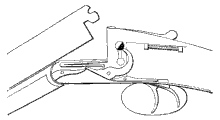Boxlock action
The boxlock action is a hammerless action of a type commonly used in double-barreled shotguns, dating back to 1875. It was developed by Anson and Deeley, based on the earlier Westley Richards action. The boxlock action uses concealed, self-cocking hammers in a break-open action. Strongly opposed by most sportsmen and manufacturers at first, the boxlock action quickly became the dominant form of double-barreled shotgun action.[1][2]

History
The boxlock action was the result of a long evolution of hammerless actions, created by two gunsmiths, Anson and Deeley, working for the Westley-Richards company in 1875. The contribution of Anson and Deeley was in the simple and elegant lock mechanism, which provided a hammerless action with fewer moving parts than exposed hammer models available at the time. This allowed a rugged and simple action which was faster to operate than exposed hammer guns. The original model, pictured above, used a hammer block safety, which was problematic, as it was possible for the gun to discharge when the safety was released. An 1882 improvement incorporated a trigger block safety, which was automatically engaged when the hammers were cocked. This type of automatic safety is still prevalent in modern boxlock actions.[3][4]
Mechanism
See also
- Shotgun – Firearm intended for firing a bolus of small pellets
References
- "Action, Boxlock". SAAMI. Archived from the original on 2008-04-09.
- Daniel Coit Gilman; Harry Thurston Peck; Frank Moore Colby (1904). The New International Encyclopædia. Dodd, Mead and Company. p. 808.
- John Henry Walsh (1882). The Modern Sportsman's Gun and Rifle. Horace Cox. pp. 183–189.
- Dave Anderson (Feb 2002). "New Weatherby Firearms For 2001". Guns Magazine.
- Henrotin, Gerard The Boxlock pistols explained, HLebooks.com, 2009